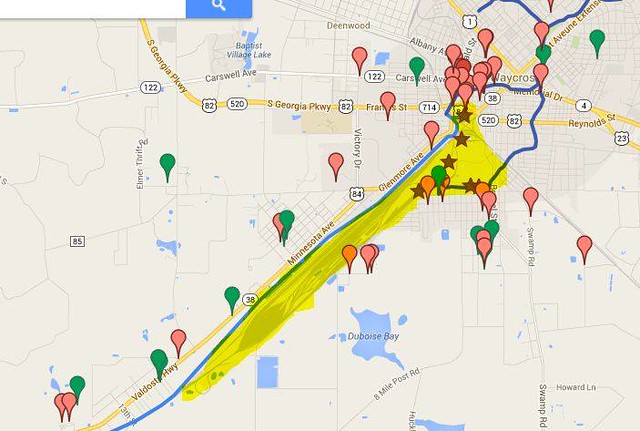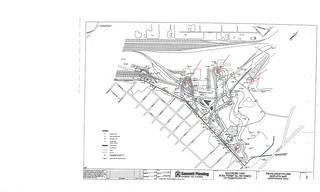The MCLG forAround the Seven Out and CSX contamination areas in Waycross more than 100 people have gotten sick or died, most since 2000, with groundwater contamination known since 1985, according to Joan Martin McNeal, So the CSX problem long predates the Seven Out problem. Here’s her map of the CSX property (in yellow) and contamination, sickness, and death:
trichloroethylene
is zero.

brown stars: known contamination areas
red markers: confirmed deceased or confirmed cases of severe illness
mostly cancer (bone, lung, prostate, blood, colon, breast),
some severe neurological disorders, some heart failure,
with ages ranging from 4 to 85 years.
green markers: likely early stage cases of such problems
According to this February 2000
 tricholoroethylene isopleth map,
there was already extensive contamination in the CSX railyard by 2000,
extending across an internal drainage ditch that goes into the
Waycross Canal that become Tebeau Creek, running through downtown
Waycross into the Satilla River.
tricholoroethylene isopleth map,
there was already extensive contamination in the CSX railyard by 2000,
extending across an internal drainage ditch that goes into the
Waycross Canal that become Tebeau Creek, running through downtown
Waycross into the Satilla River.
According to U.S. EPA, Trichloroethylene 79-01-6 Hazard Summary-Created in April 1992; Revised in January 2000,
Acute (short-term) and chronic (long-term) inhalation exposure to trichloroethylene can affect the human central nervous system (CNS), with symptoms such as dizziness, headaches, confusion, euphoria, facial numbness, and weakness. Liver, kidney, immunological, endocrine, and developmental effects have also been reported in humans. A recent analysis of available epidemiological studies reports trichloroethylene exposure to be associated with several types of cancers in humans, especially kidney, liver, cervix, and lymphatic system. Animal studies have reported increases in lung, liver, kidney, and testicular tumors and lymphoma.
According to U.S. EPA’s Basic Information about Trichloroethylene in Drinking Water,
What are EPA’s drinking water regulations for trichloroethylene?
In 1974, Congress passed the Safe Drinking Water Act. This law requires EPA to determine the level of contaminants in drinking water at which no adverse health effects are likely to occur. These non-enforceable health goals, based solely on possible health risks and exposure over a lifetime with an adequate margin of safety, are called maximum contaminant level goals (MCLG). Contaminants are any physical, chemical, biological or radiological substances or matter in water.
The MCLG for trichloroethylene is zero. EPA has set this level of protection based on the best available science to prevent potential health problems. EPA has set an enforceable regulation for trichloroethylene, called a maximum contaminant level (MCL), at 0.005 mg/L or 5 ppb. MCLs are set as close to the health goals as possible, considering cost, benefits and the ability of public water systems to detect and remove contaminants using suitable treatment technologies.
I don’t know how far back this problem goes, or exactly where or who it has affected. It’s not clear anybody else does yet, either. But I do know there’s a problem.
If you have been affected, here’s a survey you can fill out to help collect information to better determine the affected area.
-jsq
Short Link:
Pingback: From Seven Out in Waycross to CSX to Pecan Row Landfill in Lowndes County | On the LAKE front